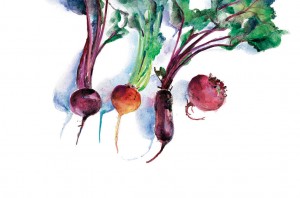Beauty and the Beet
As winter approaches, the last of summer’s abundant greens start to droop and suffer from cool fall evenings. Fortunately, the season of root vegetables comes to the rescue.
As winter approaches, the last of summer’s abundant greens start to droop and suffer from cool fall evenings. This brings sadness to the hearts of chefs like me. The summer, with week after week of diverse vibrant harvests, provided a wealth of wonderful produce and menu inspiration. The thought of the long winter ahead, with nary a green vegetable to sauté, can be a bit depressing.
Fortunately, the season of root vegetables comes to the rescue.
Fall brings its own abundance, in the form of taproots, tubers, rhizomes, corms and bulbs. Perhaps my favourite is one of the more under-appreciated and underutilized vegetables: the beet.
The beet is not easy to love. It has a tough exterior, makes a mess of your kitchen, and threatens to slide off your plate and stain your linens. However, as we learn in life, sometimes the most complicated, messy, challenging situations provide the most gratifying results. Once we learn how to handle them, life becomes beautiful again and we wonder why we were ever afraid.
So how to handle the difficult beet? The cleanest way is to first trim the leaves off the bulb, then wrap each in foil, place on a pan and roast in the oven until tender. An average tray of beets that are three inches in diameter will cook in about 30 minutes at 350°f.
Remove from the oven and unwrap from the foil. Once they are cool to the touch, use a heavy paper towel or an old dish rag to gently rub away the skin.
A cooked beet will slice very easily. To collect the beet juices and avoid staining your cutting board, place a sheet of waxed paper or thick plastic wrap across your board before you chop.
Personally, I think the brilliant flesh of a traditional beet is a glorious and rare colour among food. It is worth a little trouble to create a stunning red and purple salad or a velvety hot pink soup, or to serve a blackened gem with a roaring fuschia centre next to a seared steak.
Once you’ve befriended the beet, I encourage you to experiment. Try using beets as you would potatoes or other root vegetables.
After roasting, leave in their jackets and crush the inside flesh with a fork, adding a little cream and fresh dill. Try a scalloped version with chèvre, or dice and add to a quinoa salad with a bit of mint.
Thinly sliced with a mandoline, tossed in olive oil and sea salt, beets also make wonderful, nutrition-rich oven-baked chips.
Nevertheless, if the threat of a purple explosion in your kitchen is more than you can countenance, specialty golden beets and white beets are a kinder, gentler way to enjoy the versatility of this vegetable.
These varieties are not always available in grocery stores, but their rarity is what makes them special. At this time of year you can often fi nd them at farmers’ markets and roadside stands.
Yellow beets tend to be slightly milder and sweeter than red beets and can be used raw for salads and crudités. White beets are usually threaded with pink stripes and make a very pretty presentation when sliced.
Golden, ruby red, or pink and white, beets will add a jewel-like element to any plate. Your guests, like mine, will appreciate the visual beauty and wonderfully sweet earthy taste, while you bask in the glory of having tamed the beets.
Roasted Organic Beets with Herbed Goat’s Cheese and Chive Oil
3 red beets
3 yellow beets
3 white beets
3 oz olive oil
5 oz goat’s cheese
2 stalks fresh thyme, washed, picked and chopped
1 stalk fresh rosemary, washed, picked and chopped
3 leaves fresh sage, washed, picked and chopped
3 leaves fresh basil, washed,
picked and chopped
2 stalks flat-leaf parsley, washed, picked and chopped
1 shallot, very finely diced
¾ cup grape seed oil
¼ cup rice wine vinegar
2 tbsp lemon juice
1 bunch chives, very finely cut
Trim any stem off of the beets. Rub olive oil all over the beets, coating lightly. Wrap each beet tightly with aluminum foil. Roast in the oven at 350°F until tender.
In the meantime, place cheese in a mixing bowl. Let the cheese warm up to room temperature as you chop all the herbs. Mix the herbs into the goat’s cheese and season with salt and pepper.
Peel and cut the beets into 3?8-inch-thick medallions. Blend the grape seed oil, rice wine vinegar, lemon juice and chives at high speed until all the bits of chive are completely puréed.
To plate, layer the beets with ½ tbsp of goat’s cheese mixture between each slice. Drizzle with the chive oil.
Serves 6.







